2024 October 7 morning
Aziza Cooper writes that, between 2 and 5 pm on October 6, she counted at least 20 Cabbage Whites in the Martindale area.
She photographed the dragonfly and the drone fly shown below.
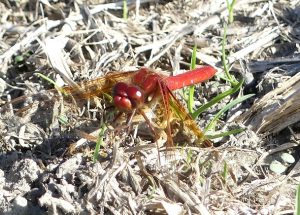 Autumn Meadowhawk Sympetrum vicinum (Odo.: Libellulidae) Aziza Cooper
Autumn Meadowhawk Sympetrum vicinum (Odo.: Libellulidae) Aziza Cooper
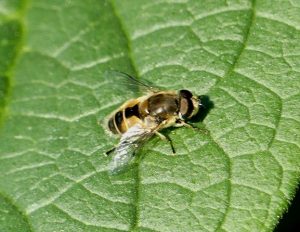 European Drone Fly Eristalis arbustorum (Dip.: Syrphidae) Aziza Cooper
European Drone Fly Eristalis arbustorum (Dip.: Syrphidae) Aziza Cooper
This makes an interesting comparison with the Common Drone Fly E. tenax photographed by Aziza on September 30, shown here on October 4. E. tenax is called the Common Drone Fly, and E. arbustorum is called the European Drone Fly, although both are common and both are European.
We haven’t yet had any reports his month of the Banded Woolly Bear, although October is the month where they are usually very common. Panama Flats may be a good place to find one. By the way, in case you find one and are tempted to try to rear it to adulthood, please be aware that this is one of the most difficult caterpillars to rear successfully.
Ian Cooper obtained the following photographs on October 5 by the Galloping Goose Trail near Harriet Road.
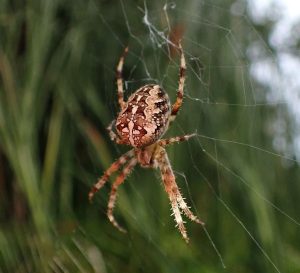 Cross Orb-weaver Araneus diadematus (Ara.: Araneidae) Ian Cooper
Cross Orb-weaver Araneus diadematus (Ara.: Araneidae) Ian Cooper
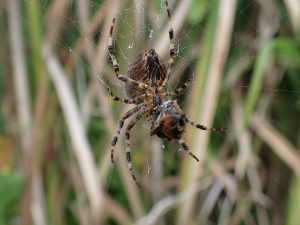 Cross Orb-weaver Araneus diadematus (Ara.: Araneidae) with prey Ian Cooper
Cross Orb-weaver Araneus diadematus (Ara.: Araneidae) with prey Ian Cooper
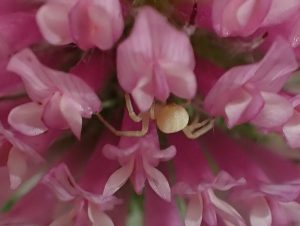 Goldenrod Crab Spider Misumena vatia (Ara.: Thomisidae) in clover blossom Ian Cooper
Goldenrod Crab Spider Misumena vatia (Ara.: Thomisidae) in clover blossom Ian Cooper
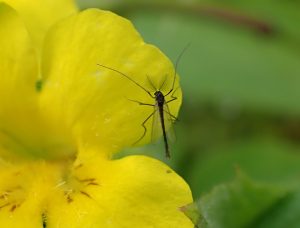 Midge (Dip.: Probably Chironomidae) Ian Cooper
Midge (Dip.: Probably Chironomidae) Ian Cooper
 Thrips (Thysanoptera) on a Cat’s Ear blossom (Hypochaeris radicata) Ian Cooper
Thrips (Thysanoptera) on a Cat’s Ear blossom (Hypochaeris radicata) Ian Cooper
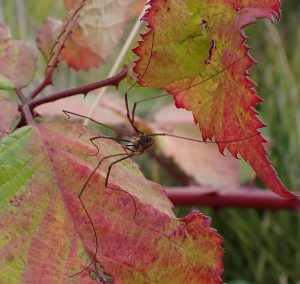 Harvestman (Opiliones) Ian Cooper
Harvestman (Opiliones) Ian Cooper
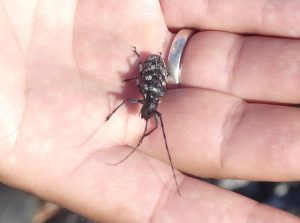 Spotted Pine Sawyer Monochamus clamator (Col.: Cerambycidae) Aziza Cooper
Spotted Pine Sawyer Monochamus clamator (Col.: Cerambycidae) Aziza Cooper
 Autumn Meadowhawk Sympetrum vicinum (Odo.: Libellulidae) Aziza Cooper
Autumn Meadowhawk Sympetrum vicinum (Odo.: Libellulidae) Aziza Cooper European Drone Fly Eristalis arbustorum (Dip.: Syrphidae) Aziza Cooper
European Drone Fly Eristalis arbustorum (Dip.: Syrphidae) Aziza Cooper Cross Orb-weaver Araneus diadematus (Ara.: Araneidae) Ian Cooper
Cross Orb-weaver Araneus diadematus (Ara.: Araneidae) Ian Cooper Cross Orb-weaver Araneus diadematus (Ara.: Araneidae) with prey Ian Cooper
Cross Orb-weaver Araneus diadematus (Ara.: Araneidae) with prey Ian Cooper Goldenrod Crab Spider Misumena vatia (Ara.: Thomisidae) in clover blossom Ian Cooper
Goldenrod Crab Spider Misumena vatia (Ara.: Thomisidae) in clover blossom Ian Cooper Midge (Dip.: Probably Chironomidae) Ian Cooper
Midge (Dip.: Probably Chironomidae) Ian Cooper Thrips (Thysanoptera) on a Cat’s Ear blossom (Hypochaeris radicata) Ian Cooper
Thrips (Thysanoptera) on a Cat’s Ear blossom (Hypochaeris radicata) Ian Cooper Harvestman (Opiliones) Ian Cooper
Harvestman (Opiliones) Ian Cooper